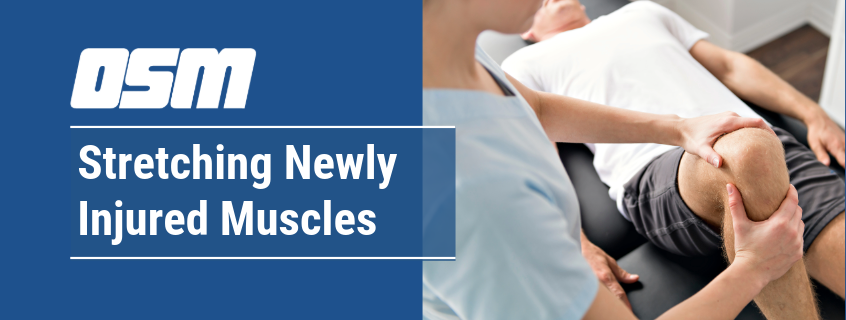Stretching Newly Injured Muscles
Article featured on Children’s Hospital Colorado
Most young athletes know that injuries are possible when they’re active and a training injury or soreness is almost inevitable. So, what can you do to help heal from minor muscle injuries? Stretching, for one. Pretty much everyone can do it, but you have to know how and when it’s appropriate.
Which muscle injuries can you stretch?
The first thing to understand is which muscle injuries are OK for stretching and which aren’t. Two of the most common muscle injuries for young athletes are:
- Muscle strain: stretching or tearing of muscle fibers
- Muscle contusion (also called a muscle bruise): injury to muscle fibers, connective tissue or blood vessels usually from a direct blow
Stretching can help you heal from a muscle strain, as long as it’s not severe. Stretching can also help when healing a new muscle contusion. For example, our athletic trainers often recommend simultaneously icing and stretching quad contusions right after the injury.
What is a muscle strain?
Also known as a pulled or torn muscle, a muscle strain is when the muscle fibers pull apart from each other and are damaged. This can come from putting too much weight on the muscle, overuse or fatigue, an accident or using the muscle incorrectly. The right stretch at the right time is a key component in that treatment plan.
Stretching is not only important to prevent further injury and scar tissue, but also helps a newly injured muscle lengthen to release the body’s natural response to spasm. Young athletes can often pull a muscle by doing exercises incorrectly or during their sports.
The dos of stretching a newly injured muscle
The most important thing to pay attention to is the kind of pain you’re feeling.
“A good indicator when it’s OK to begin gentle stretching is when the pain in the injured area has shifted from sharp or stabbing to more of a soreness or stiffness,” says Coonan. “You shouldn’t start until that happens.”
When stretching a newly injured muscle, it will help if you:
- Do wait three days to a week after the injury, depending on severity and symptoms, to begin stretching. Using pain as a guide; if you feel sharp pain in the injured area, it means it is too early to start stretching.
- Do wait until the inflammation mostly goes away before the first stretch.
- Do start with gentle static stretching – reach and hold rather than doing movement-based stretching.
- Do ensure the stretching is mostly pain-free to help the healing process.
- Do incorporate a consistent dynamic warm-up routine and include static stretching after an activity to prevent soreness and improve flexibility.
The don’ts of stretching a newly injured muscle
Timing is everything when it comes to what you shouldn’t do when stretching an injured muscle. If your muscle isn’t relaxed, it can affect the muscles around it.
“Stretching before the muscle can relax is setting yourself up for further injury,” says Coonan.
When stretching a newly strained muscle:
- Don’t necessarily use the rest, ice, compress and elevate (RICE) method right away to begin healing a strained muscle. Coonan explains that using ice later to alleviate some spasms can help but slapping on ice right after an injury can actually increase healing time. Compression and rest can be helpful in a newly strained muscle depending on the severity of the injury.
- Don’t push your stretch “just a little bit farther” than comfortable. This can delay the healing process.
- Don’t wait too long to begin stretching. For a minor strain that may be just a few days. For a moderate strain that could be 1 to 2 weeks and for a severe strain that could extend to 2 to 6 weeks. Waiting too long can create scar tissue, reducing flexibility and strength.
- Don’t immediately return to Understanding what your body needs most, regardless of severity, is the most important aspect of stretching and healing an injured muscle. You should be pain free, back to full strength and flexibility and have completed a slow ramp-up of activity to ensure the area doesn’t feel aggravated.
The Orthopedic & Sports Medicine Center of Oregon is an award-winning, board-certified orthopedic group located in downtown Portland Oregon. We utilize both surgical and nonsurgical means to treat musculoskeletal trauma, spine diseases, foot and ankle conditions, sports injuries, degenerative diseases, infections, tumors and congenital disorders.
Our mission is to return our patients back to pain-free mobility and full strength as quickly and painlessly as possible using both surgical and non-surgical orthopedic procedures.
Our expert physicians provide leading-edge, comprehensive care in the diagnosis and treatment of orthopedic conditions, including total joint replacement and sports medicine. We apply the latest state-of-the-art techniques in order to return our patients to their active lifestyle.
If you’re looking for compassionate, expert orthopedic and podiatric surgeons in Portland Oregon, contact OSM today.
Phone:
503-224-8399
Address
17355 Lower Boones Ferry Rd Suite 100A
Lake Oswego, OR 97035
Hours
Monday–Friday
8:00am – 4:30pm



